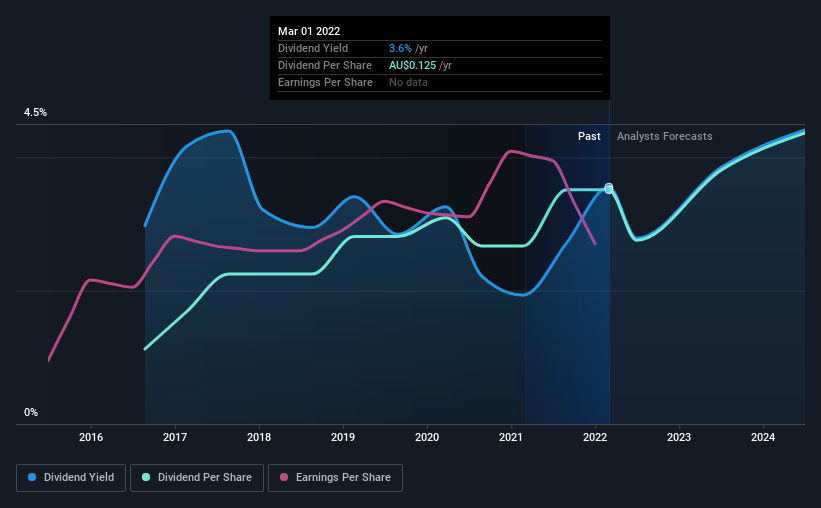- Australia
- /
- Healthcare Services
- /
- ASX:IDX
Integral Diagnostics (ASX:IDX) Is Paying Out Less In Dividends Than Last Year
Integral Diagnostics Limited (ASX:IDX) has announced it will be reducing its dividend payable on the 4th of April to AU$0.04. The dividend yield of 4.3% is still a nice boost to shareholder returns, despite the cut.
See our latest analysis for Integral Diagnostics
Integral Diagnostics Doesn't Earn Enough To Cover Its Payments
If the payments aren't sustainable, a high yield for a few years won't matter that much. Based on the last payment, the company wasn't making enough to cover what it was paying to shareholders. Without profits and cash flows increasing, it would be difficult for the company to continue paying the dividend at this level.
Over the next year, EPS is forecast to expand by 50.8%. If the dividend continues on its recent course, the payout ratio in 12 months could be 104%, which is a bit high and could start applying pressure to the balance sheet.

Integral Diagnostics' Dividend Has Lacked Consistency
Even in its relatively short history, the company has reduced the dividend at least once. Due to this, we are a little bit cautious about the dividend consistency over a full economic cycle. The dividend has gone from AU$0.04 in 2016 to the most recent annual payment of AU$0.13. This implies that the company grew its distributions at a yearly rate of about 21% over that duration. It is great to see strong growth in the dividend payments, but cuts are concerning as it may indicate the payout policy is too ambitious.
Integral Diagnostics May Find It Hard To Grow The Dividend
With a relatively unstable dividend, it's even more important to evaluate if earnings per share is growing, which could point to a growing dividend in the future. Integral Diagnostics hasn't seen much change in its earnings per share over the last five years.
We're Not Big Fans Of Integral Diagnostics' Dividend
To sum up, we don't like when dividends are cut, but in this case the dividend may have been too high to begin with. The company's earnings aren't high enough to be making such big distributions, and it isn't backed up by strong growth or consistency either. The dividend doesn't inspire confidence that it will provide solid income in the future.
Market movements attest to how highly valued a consistent dividend policy is compared to one which is more unpredictable. Meanwhile, despite the importance of dividend payments, they are not the only factors our readers should know when assessing a company. As an example, we've identified 5 warning signs for Integral Diagnostics that you should be aware of before investing. Is Integral Diagnostics not quite the opportunity you were looking for? Why not check out our selection of top dividend stocks.
New: AI Stock Screener & Alerts
Our new AI Stock Screener scans the market every day to uncover opportunities.
• Dividend Powerhouses (3%+ Yield)
• Undervalued Small Caps with Insider Buying
• High growth Tech and AI Companies
Or build your own from over 50 metrics.
Have feedback on this article? Concerned about the content? Get in touch with us directly. Alternatively, email editorial-team (at) simplywallst.com.
This article by Simply Wall St is general in nature. We provide commentary based on historical data and analyst forecasts only using an unbiased methodology and our articles are not intended to be financial advice. It does not constitute a recommendation to buy or sell any stock, and does not take account of your objectives, or your financial situation. We aim to bring you long-term focused analysis driven by fundamental data. Note that our analysis may not factor in the latest price-sensitive company announcements or qualitative material. Simply Wall St has no position in any stocks mentioned.
About ASX:IDX
Integral Diagnostics
A healthcare services company, provides diagnostic imaging services to general practitioners, medical specialists, and allied health professionals and their patients in Australia and New Zealand.
Good value with reasonable growth potential.
Market Insights
Community Narratives



